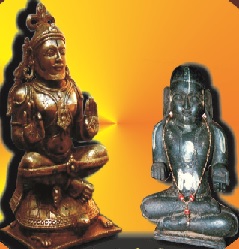Mahabharata Tatparya Nirnaya
 Sri Madhwacharya was the first to recognize the spiritual wealth of Mahabharata and establish that it was
essentially a spiritual work of profound depth. In the second chapter, he explains the significance of
the terms, Manvadi, Astikadi, Upacharadi and establishes with quotations from scriptures as to how Kauravas,
Pandavas and their followers personify the various spiritual principles.
Sri Madhwacharya was the first to recognize the spiritual wealth of Mahabharata and establish that it was
essentially a spiritual work of profound depth. In the second chapter, he explains the significance of
the terms, Manvadi, Astikadi, Upacharadi and establishes with quotations from scriptures as to how Kauravas,
Pandavas and their followers personify the various spiritual principles.
Sri Madhwacharya composed this work as per the directive of Sri Vedavyasa when he went to Badari the
second time.
Mahabharata and Ramayana are two epics which give us an insight into the Vedic culture. These provide gripping
story content to the layman and profound spiritual truths to the scholars which make them equally popular with
both.
Mahabharata, with its mammoth size and profound thought provoking truths, is considered as the spiritual encyclopedia.
Its wide interpretation potential will keep it ever enigmatic.
Ramayana is another unique work. Though Rama's story is depicted in various works like Valmiki Ramayana, its origin is Moola
Ramayana authored by Lord Hayagreeva containing a hundred crore (1 Billion) verses. It is also known as Hayagreeva Ramayana.
It is a unique work. Valmiki Ramayana is the condensed version of Hayagreeva Ramayana. According to Matsya Purana, Lord Hayagreeva
preached it to Chaturmukha Brahma and through him Narada got the sermon, who in turn transmitted it to Valmiki. Valmiki condensed it
and presented it in Twenty-four Thousand Shlokas. The very first Shloka of Valmiki Ramayana supports all these details, but
nobody except Srimadacharya had noticed these.
Acharya Madhwa is the only spiritual teacher who provided comprehensive interpretation and information on these epics.
The others have dwelt only on certain sentences here and there without even touching on the spiritual import of the passages.
Thus the help rendered by Sri Madhwacharya's work to the thinkers is immense. Mahabharata Tatparya Nirnaya is the largest of
all Acharya Madhwa's Krutis, containing more than Five Thousand Shlokas. Such a massive work in Shloka form is very rare in
Sanskrit literature. It explains entire Mahabharata and Ramayana in Thirty-Two chapters.
There are very few works which have attempted to present Moola Mahabharata of One Lakh verses, concisely without omitting any
portion of significance and no one has been as successful in this endeavor as Sri Madhwacharya. The only noteworthy work
in this area could be Kshemendra's Bharatamanjari. Though it is an elaborate work, it has failed in capturing the essence of
the Moola. The depiction is too mechanical, not comprehensive and in several places unsatisfactory. Srimadacharya's work,
in striking contrast, is amazing and holds the reader spellbound with its narration - especially the, description of the
war episodes. Perhaps, after Mahabharata this is the only work, which excels in clarity, neatness of depiction and
unambiguous interpretation.
As already mentioned Moola Ramayana is a mammoth epic extending over Hundred Crore verses. Before Sri Madhwa, even the existence
of the work was not known to the people, let alone the matter of bringing out commentaries or explanatory works. Kshemendra's
Ramayanamanjari covers only Valmiki Ramayana. But, just as in the case of his Bharatamanjari, it limits itself to the
story content of the work and does not touch the fields of interpretation or analysis. Even the other works like
Anantabhatta's Champubharata, Bhoja's ChampuRamayana suffer from the same limitations. Considering all these,
Acharya Madhwa's Sri Mahabharata Tatparya Nirnaya is the only work which analyses and explains every intricate
situation in both Ramayana and Mahabharata and has no parallel.
Another unique feature of this work is the way in which it has utilized related works like Hari Vamsha, Bhagavata and Vishnupurana.
It should be noted that such a feat was never attempted before. This has made it an interpretative work on these as well,
in addition to Mahabharata and Ramayana. It highlights the importance of the characters of Hanumantha and Bhimasena in the
epics and therefrom the Vayu Jeevottamatva (the primacy of Vayu among all Jeevas) .